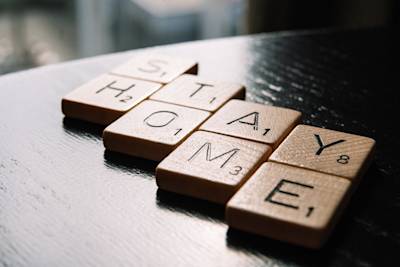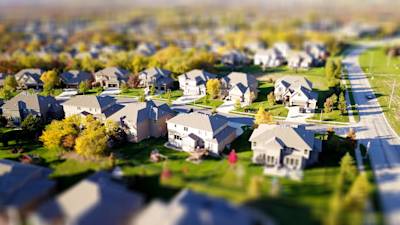
6 Ways COVID-19 Has Affected the Real Estate Industry
Real Estate Industry Predictions for 2021

Real Estate Industry Predictions for 2021

Jacqueline Kyo Thomas
Is your real estate business still reeling from the whirlwind year that was 2020? Or are you all set to finally get your real estate license in 2021, but not sure what it's like to actually sell real estate during the aftermath of a pandemic?
We’ve got you covered.
In this post, we discuss how COVID-19 has changed the real estate industry and what it may mean for your real estate business in 2021.
Let’s dive in.

Life has changed in many ways since March 2020, but one of the biggest changes was social distancing. The things we took for granted — such as hosting open houses, touring properties, shaking hands - became a health hazard in 2020.
The social distancing orders gave rise to “stay at home” culture. Even though many of these restrictions have eased or been lifted, there’s still a tendency amongst the general public to stay close to home and only venture out when necessary.
Here’s how stay at home culture impacts real estate: Buyers are less likely to schedule property tours of homes that they’re not sure they're absolutely interested in. They’re less likely to attend open houses – and real estate agents are also less likely to host them.
But this doesn’t mean that you can’t host open houses or conduct property tours. It simply means that you need to shift the way that you do it. Go virtual.
Check out our tips on how to conduct a virtual property tour for beginners.
People aren’t just staying close to home when they’re off work. Many people are also working from home. Recent studies show that 1 out of 4 Americans will work from home in 2021. That’s 25%. By comparison, only 5.2% of Americans worked from home in 2017.
Although many Americans are resuming working at their normal jobs outside of the home, some are choosing to work remotely, and some are working in hybrid arrangements where they only go into an office a few days a week. This is in addition to the steady rise in remote jobs which was happening before the pandemic. Thanks to tools like Zoom and a stable and quick Internet, many Americans can work from home—and be more productive doing so.
Here’s how remote work impacts real estate: Because there’s been such a dramatic and sudden shift to remote work, many home buyers have changed their list of must-haves.
They’re now looking for homes that can accommodate their work needs. Instead of open floor plans, many want homes that have distinct living and working spaces. This includes homes that come with a dedicated home office (instead of carving out a corner in a flex space or guest bedroom). Many buyers are looking for properties that can give them space for relaxation and work. This also includes plenty of outdoor space.
It’s a seller’s market, which is good news for homeowners, but conflicting news for those in the market to buy – we’ll discuss why this may be confusing later.
The global pandemic limited or downright stopped new home development and production for several months last year. Plus, perhaps in response to the uncertainty brought on by the pandemic, fewer people listed their homes for sale in 2020.
There are now many fewer homes on the market.
This has led to a rise in home values for all existing properties. In 2020, home values in the United States went up by 9.1%. And that’s not all. They’re expected to continue rising in 2021 to 10.1% according to Zillow.
Here’s how rising home values impacts real estate: Sellers are in a great position to sell their home for asking or above. If you’re a seller’s agent, you may find it easier to market and sell properties this year. If you’re a buyer’s agent, you definitely need to prepare your clients to act quickly, and offer thoughtfully.

Have you heard of “The Great Coronavirus Migration?” In reaction to the global pandemic, it’s the exodus from city to suburb, or even the countryside.
While many moves were temporary, a lot of people have decided to make a permanent move to the suburbs or rural areas. Many people believe that the handling of the pandemic in general, and the recent 2021 Texas power crisis, have revealed weaknesses in our current infrastructures. It’s a valid fear: Can big cities support a growing population and its increasing demands?
Fears surrounding the pandemic prompted some people to quickly but temporarily evacuate cities. But others used the pandemic as an opportunity to expand their house hunt beyond city limits to get more bang for their buck. Couple this with the shift to remote work, and many people no longer needed to live close to public transportation or within 30 minutes of the city. While the demise of cities is probably overhyped in the media - cities have existed for millenia, and they're not going away any time soon - it is likely that there will be an overall decrease in demand for urban real estate, and corresponding increase in demand in suburban and rural markets. The magnitude of this change is up for debate, but some shift seems pretty likely based on the sudden expansion of remote work noted above, combined with how expensive urban markets have become in the past decade.
Here’s how migration from cities impacts real estate: Buyers are more open-minded when it comes to looking for properties outside of the city, or even the state. Many want to know how far they can stretch their dollar, and have embraced the idea of working and living remotely.
In many areas, it costs more to build right now than it does to buy. That’s because the price of lumber (and other supplies) is on the rise. Lumber prices have skyrocketed. Softwood lumber is now 112% higher than in February 2020.
There are a lot of factors that go into lumber price spikes, but 2020’s labor shortage is the biggest factor. Another contributor is the rise in demand for lumber. Everyone was stuck at home in 2020. Many people chose to renovate their homes and tackle DIY projects last year which led to a rise in lumber costs. While prices should come down over time as vaccinations become more widely available, expect to see an impact in 2021.
Here’s how rising building costs impact real estate: Builders have no choice but to pass on the material costs to buyers. So, it makes more sense for many house hunters to buy a home that’s already built. It’s cheaper to buy an existing home (even though home values and prices are still at record highs). This leads us to our next point.
While buying an existing home may be cheaper than building a new one, it doesn’t mean that home buying in 2021 is cheap. As we discussed above, home values are rising. And accordingly, home prices are also rising. The simple law of supply and demand tells us that lower supply equates greater demand. There are fewer properties available and so the demand for those houses is much greater.
Couple that with the fact that mortgage rates are at a historic low, and you’ve got a hungry real estate market.
In 2020, the Federal Reserve cut interest rates to 0%. What followed was record low mortgage rates. In January 2021, the average interest rate on a 30-year, fixed rate mortgage plummeted to 2.65%—a rate that hasn't been seen since the early 1970s.
Here’s how record low mortgage rates impact real estate: Even though it's a seller's market, it's still a good time to buy. The low interest rates can take the bite away from the steep rise in home prices. A 1% difference in mortgage rate can equate to tens of thousands dollars over a 30-year term. So, buying a home that costs more with a smaller mortgage rate may be more affordable in the long run.
A $400,000 home at 3.92% will be $680,853 after a mortgage period of 30 years. By comparison, a $420,000 home at 2.71% will be $614,062. That's a savings of over $66,000.
Communicate to your clients that 2021’s record low mortgage rates will have a positive impact on home affordability even though prices are much higher.
Current low interest rates should also motivate buyers to act now instead of later. Experts predict that interest rates will rise by the end of 2021.
COVID-19 has definitely changed the way that we do real estate, but it hasn’t decreased the need for real estate services. As long as there are people, there will always be a need for shelter.
Use the above insights to shape your business strategies for 2021.
Before you go, check out these related posts: